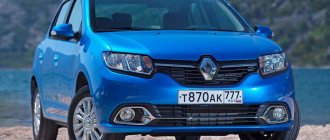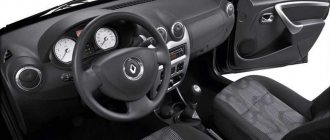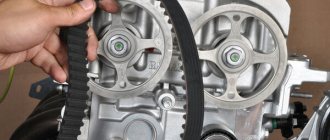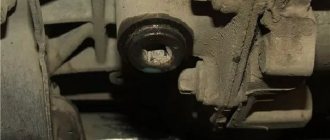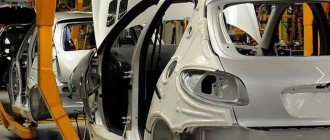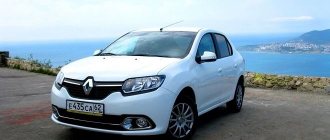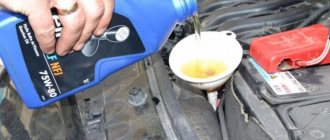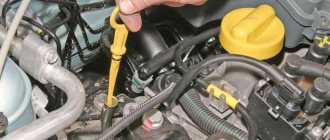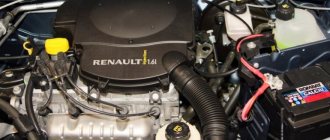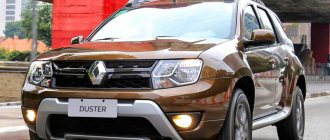The debut of the first generation Renault Logan occurred in 2004 . The model was conceived by the French as an affordable subcompact car for the markets of developing countries. The main production was launched in Romania at the Dacia plant , a controlling stake in which belongs to Renault. A year later, assembly was established in our country at the Moscow Avtoframos plant , later renamed Renault Russia (production years 2005-2015).
The characteristics of the Renault Logan 1 engines are not outstanding, but the reliable design and price did their job - the car was successfully sold in many countries around the world.
Appearance Renault Logan 1
Renault Logan 2004-2009
- before restyling The exterior of the 2005 Renault Logan is simple to the point of disgrace - this is the kingdom of straight lines . There is nothing to catch the eye here, but despite this, the car is recognizable in traffic and in the photo.
Renault Logan I generation after restyling
A simple radiator grille with a diamond in the center and beveled edges touches the simple head optics. Bumper with small round fog lights. The additional air duct is protected by a cellular plastic mesh. On the sloping hood there are featureless longitudinal stampings extending to the large windshield.
Renault Logan 2004-2009
On the side everything is also fresh. Only the slight relief of the wheel arches of the first generation Logan stands out slightly from the overall picture. The straight roof rests on wide rear pillars. The door handles look very budget-friendly, and they can’t be called comfortable. When opening it you have to put your hand underneath. The lock cylinders are embedded directly into the door panel, which is why a careless movement can scratch the paint on the body.
Renault Logan 2013
At the rear of the Renault Logan 1 2006, a huge trunk lid crowds the taillights, which are modestly nestled at the edges. The bumper is no frills with a towing eye peeking out on the right. Does not leave an obsessive feeling of emptiness. They slightly changed the design for the better after restyling , adding chrome edging to the hood and trunk , making a stamping at the back that imitates a spoiler and changing the radiator grille and bumpers.
Renault Logan 1 - model description
Description of the car Renault Logan 1
Renault Logan of the first generation has a reputation as a very comfortable passenger car and a non-destructive vehicle. It was assembled at a French state concern and was developed specifically for third world countries. This means that it is characterized by simplicity, efficiency and easy availability of spare parts. This is a very reliable, unpretentious and repairable car. Renault Logan is loved by taxi drivers for its spacious interior, and by summer residents for its high ground clearance of 155 mm.
In Russia, the first generation was produced from 2005 to 2015. The Logan family has many “relatives” and differs in names depending on the specifics of the market. For example, in European countries and Morocco this car is called “Dacha Logan”, and in the Mexican market it is sold under the name “Nissan Aprio”, in India – “Mahindra Verito”.
The article was written in support of our Nissan and Renault spare parts store, where you can buy auto parts for Renault Logan 1 at a competitive price.
Exterior Renault Logan 1
Logan's appearance is tall, compact and angular. The sedan combines a minimum of luxury and a maximum of practicality.
In 2008, after an upgrade, Logan received a new chrome grille, enlarged headlights and new bumpers. And also the length of its body increased by 4 cm.
Salon Renault Logan 1
The interior interior is very spacious and roomy. The seats are upholstered in inexpensive DUCAS fabric. There is a cigarette lighter and ashtray, an air recirculation system and a heated rear window.
The dashboard with the dashboard is made of two-color plastic: black and gray. The car radio, fuel and coolant indicators are minimalistic. Everything is simple and intuitive.
The seats are soft without side supports, the rear sofa is solid. The front seats are only adjustable horizontally.
The “internals” most likely hint that this is not a private car, but a commercial vehicle. Everything says that the main thing is to go, and the rest is not important.
To unfold the rear seat for transporting large luggage, you need to remove the rear backrest: Remove the seat from its hinges, unscrew the screws at the backrest, then unscrew the additional iron seat frame with 4 bolts. In short, a very “fun” activity for a spacious family car.
The trunk has an impressive volume of 510 liters.
Transmission and Engine Renault Logan 1
Simplicity and reliability are the motto of Renault Logan 1 engines. Their reliability is legendary.
Regardless of engine size, the first generation Renault Logan had only a manual gearbox and front-wheel drive transmission design. On the Russian market, all engines are presented in gasoline versions.
Renault Logan 1 engines have their own developed classification. That's why you'll notice the following abbreviations: K7J, K7M, K4M: The K stands for a family of inline four-cylinder engines. The second number “4” means that the engine has 16 valves, and the number “7” will indicate an 8 valve engine. The third letter indicates the engine size: “J” = 1.4 l., “M” = 1.6 l.
At the dawn of the production of the first generation from 2004 to 2009, two types of engine were developed: 1.4 liters (75 hp, K7J) and 1.6 liters (90 hp, K7M).
In 2009, restyling took place and until 2021, cars were produced with an automatic 4-speed gearbox and an engine capacity of 1.6 liters (103 hp, K4M). The 1.4-liter engine remained unchanged, and the 1.6-liter with a five-speed manual transmission began to be sold in two versions: 82 horsepower K7M (the most common type) and 103 horsepower K4M engines.
Average fuel consumption does not vary much and with a mixed operating cycle will be approximately 7 l/100 km
The Renault Logan 1 transmission has a five-speed manual and four-speed automatic transmission.
Renault Logan 1 suspension
The suspension on Renault Logan is designed so organically that it is associated with a rubber ball. It's so easy and pleasant to drive off-road. The high ground clearance of 155 mm is an excellent addition to the suspension, as it increases the cross-country ability significantly.
The front, so-called MacPherson strut suspension, has arms, a rack and an anti-roll bar located on a subframe, due to which little vibration and noise from the road is transmitted to the car body. It is noteworthy that the left and right pillars are the same and do not differ between right and left.
The rear suspension is a beam mounted on powerful shock absorber silent blocks and is mounted separately from the springs, which makes them very easy to replace.
After the 2008 facelift, it was terrible news to learn that the modified cars were no longer equipped with anti-roll bars. French engineers decided to replace them with reinforced shock absorbers, although the former worked well.
Dimensions Renault Logan 1
Dimensions of the “miracle car” of the first generation 2004-2009 before restyling: length - 4250 mm, width with side mirrors folded - 1740 mm, width with side mirrors folded - 1989 mm, car height - 1534 mm. The wheelbase (the distance between the axles of the front and rear wheels) is 2630 mm. After restyling, the length of the body increased by 40 mm. Luggage compartment length 980 mm.
Spare parts Renault Logan 1
There are a large number of original and non-original spare parts for this car. There is a large selection of analogues at reasonable prices. You can get acquainted with them in the section “Spare parts for Renault Logan 1”. You can purchase spare parts for maintenance - oil, filters, brake pads, power steering fluids, automatic transmission fluids and others from our stock.
Salon
Torpedo Renault Logan 1st generation after restyling
minimalism rules the roost here . The ascetic dashboard with swollen round air ducts is divided by a silver-plated console with a minimal set of buttons and switches. The door opening handles on the flat door panels are made to match the console.
Torpedo Renault Logan I generation before restyling
It's comfortable to sit in the driver's seat . The plump rim of the steering wheel fits well in the palm. But in the basic version of the first generation Renault Logan 2007 there is no ability to adjust the steering column . The cheapest package is very spartan; the only options it has are a driver's airbag and heating filaments in the rear window . The finishing materials used are cheap, but the assembly is top notch, all interior elements fit tightly together.
Renault Logan "Prestige" configuration 2009
The Prestige package is more convenient for everyday use. It has everything you need : heated seats, air conditioning, electric windows and mirrors, on-board computer. In addition, the driver's seat can be adjusted in height , the mirrors are heated , and there is a central lock . But even here the radio is available only for a fee.
The second row cannot be called cramped. It is quite capable of accommodating three passengers . It’s not for nothing that Renault Logan was once actively used by taxi companies. The trunk characteristics are impressive. It holds as much as 510 liters of luggage. The disappointing thing is that the backs of the rear seats do not fold , so it will not be possible to transport something long.
The trunk holds as much as 510 liters of luggage.
Technical specifications Renault Logan 1
Only gasoline power plants were installed in the engine compartment of the sedan.
The base engine was 1.4 K7J, the alternative was the eight-valve 1.6 K7M.
The 1.4 K7J engine was offered as the base an alternative was the eight-valve 1.6 K7M. Both units had modest power indicators. The 16-valve 1.6 K4M engine appeared after restyling in 2009. With it, the car drives more fun, and it has become easier to overtake on the highway.
Renault Logan 2010 was equipped with two transmission options: 5 manual transmission or 4 automatic transmission . With a manual transmission, the car was a little faster and more economical, while the automatic transmission made it possible to move comfortably through city traffic jams.
Engine parameters
Renault Logan 1.4 K7J engine
Characteristics of Renault Logan 2011 with 1.4 K7J engine and 5-speed manual:
- acceleration to 100 km/h – 13 seconds ;
- power – 75 hp ;
- torque – 112 Nm ;
- fuel consumption (city/highway/average) – 9,5/5,5/6,8.
Engine Renault Logan 1.6 K7M
Characteristics with the 1.6 K7M engine with 5 manual transmission:
- acceleration to 100 – 11.5 seconds ;
- power – 90 hp ;
- torque – 128 Nm ;
- gasoline consumption – 10/5,8/7,3.
Before restyling, only manual transmissions (5 manual transmission) were available. Four-speed automatic transmissions appeared on the sedan in 2009.
Dimensions and volumes Logan 2009
Dimensions of Renault Logan 1st generation:
- length – 4250 mm ;
- width - 1740;
- height - 1534;
- wheelbase – 2630 mm ;
- ground clearance – 155;
- weight – 980 kg ;
- trunk volume – 510 l ;
- Fuel tank volume – 50 l .
Suspension
Budget-class cars are often the only ones in the family and are used head and shoulders. Drivers expect reliability and maintainability . The Renault Logan 2012 chassis meets these qualities.
At the front there is a problem-free McPherson with a shock-absorbing strut and a coil spring . Ball joints and wishbones are attached through silent blocks. At the rear there is a semi-independent torsion beam suspension , suspended by springs and double-acting telescopic gas shock absorbers mounted separately from each other.
Renault Logan 1st generation McPherson front suspension with shock absorber strut and coil spring.
Structural simplicity ensures reliability; Logan's suspension is easy to repair and maintain. The French have optimally balanced the driving characteristics for use in our country. The suspension provides good handling even on imperfect asphalt, and increased energy intensity contributes to a smooth ride. The turning radius is only 5.25 meters , making maneuvers in tight city yards a breeze. Based on these qualities, Logan compares favorably with its competitors in the budget segment.
Safety
Source Click to enlarge
Technical characteristics of Renault Logan generation I rest.
sedan
City car
- width 1,740mm
- length 4,288mm
- height 1,534mm
- ground clearance 155mm
- seats 5
| Engine | Name | Fuel | Drive unit | Consumption | Up to a hundred | Max. speed |
| 1.4 MT (75 hp) | expression | AI-92 | Front | 5,5 / 9,4 | 13 s | 162 km/h |
| 1.4 MT (75 hp) | authentic | AI-92 | Front | 5,5 / 9,4 | 13 s | 162 km/h |
| 1.6 MT (84 hp) | expression | AI-92 | Front | 5,9 / 10 | 11.5 s | 175 km/h |
| 1.6 MT (84 hp) | prestige | AI-92 | Front | 5,8 / 10 | 11.5 s | 175 km/h |
| 1.6 MT (84 hp) | silver line | AI-92 | Front | 5,9 / 10 | 11.5 s | 175 km/h |
| 1.6 MT (84 hp) | arctic | AI-92 | Front | 5,9 / 10 | 11.5 s | 175 km/h |
| 1.6 MT (102 hp) | expression | AI-92 | Front | 5,8 / 9,4 | 10.5 s | 180 km/h |
| 1.6 MT (102 hp) | prestige | AI-92 | Front | 5,8 / 9,4 | 10.5 s | 180 km/h |
| 1.6 AT (103 hp) | expression | AI-92 | Front | 6,7 / 11,8 | 11.7 s | 175 km/h |
| 1.6 AT (103 hp) | prestige | AI-92 | Front | 6,7 / 11,8 | 11.7 s | 175 km/h |
Looking for reviews of Renault Logan? View reviews of Renault Logan
Advantages and disadvantages of Renault Logan 1
, more than half a million had already driven on Russian roads . The sedan has become truly popular . It is still actively bought and sold on the secondary market. But in order not to run into a frankly dead specimen, you need to know the problem areas in the design and pay attention to them when purchasing. In addition, Logan was purchased en masse for work in taxi companies ; it is better to avoid such cars.
Advantages:
- price;
- available spare parts;
- one of the main advantages is the indestructible suspension and well-thought-out underbody protection;
- engines and manual transmissions were developed in the 1990s , despite their modest power, they are valued for their service life and maintainability;
- the stove warms up the interior well in winter;
- The engines start without problems even in severe frosts .
Flaws:
- power units are rather weak and have high gas consumption;
- paintwork is prone to scratches and chips;
- crickets in the cabin, this problem for Logan is almost impossible to get rid of;
- unclear ergonomics, tiny glove box, large trunk lid hinges;
- boring design.
Renault Logan problems:
- After restyling, the engines were adjusted to the Euro-4 environmental standard , this provoked problems with cold starts . The problem is solved to some extent by reflashing the control unit, but this increases fuel consumption.
- Windshield wiper mechanisms are of mediocre quality.
- often leak .
- The throttle valve assembly is not durable and is sensitive to contamination.
- On pre-restyling Renault Logan 1, the front brake pads wear out quickly and unevenly .
Review of Renault Logan I
First generation Logan engines
All engines on Logans are purely from Renault. And this guarantees the absence of serious problems, either during maintenance or during their repair. Spare parts for these engines are available in a wide range and at almost any price.
The most reliable and popular are the 1.4-liter eight-valve engine (K7J 710), which is installed in the basic version of Logan, and the slightly more powerful 1.6 (K7M 710). These engines have a long service life, can patiently withstand the installation of gas equipment and are inexpensive to repair. Minor shortcomings include oiling of the timing cover, leaking crankshaft seals, and minor glitches in the ignition coils. But more on that later.
Modifications of Renault Logan engines of the first generation.
The 16-valve 1.6-liter engine of the K4M model is also quite good. It differs from less powerful internal combustion engines in that the timing belt is more expensive to maintain. Ignition coils (and there are 4 of them) also have to be changed periodically. This car also tolerates gas with dignity, but still, for running on gas, it is better to choose an eight-valve engine.
In terms of economy, from the Logan 1 ICE line, it is of course worth highlighting the 1.5dCi diesel engines, which have modifications with 68 and 86 hp. But officially they are only available in Europe and are called Dacia. Their diesel fuel consumption does not exceed 6.5 liters per hundred. A more powerful diesel engine is equipped with a turbine and intercooler.
For those who like to tune a diesel Logan, I want to say that the gearbox of a 60-horsepower diesel engine is designed for 160 Nm of torque, while a more powerful one has a limit of 200. So approach this issue wisely, and remember - you can increase the power of a diesel Logan by only about 20 “ horses."
The weak points of a diesel engine lie in problematic and expensive injectors and short-lived liners. These problems can occur to a diesel Logan after 100,000 miles.
Chassis
The Renault Logan suspension is characterized as simple and reliable: the MacPherson strut is used on the front axle, and a conventional beam is used on the rear axle.
The car drives quite decently on Russian roads, and the relatively high ground clearance also contributes to this. This allows you to protect the underbody, gearbox, engine and other components located under the car from driving on a very poor road surface (or its complete absence in the conditions of the Russian outback).
The cost of Logan suspension parts is quite low, as is the cost of replacing them. Spare parts for Renault Logan of the first generation can be called the cheapest on the auto parts market. An interesting point: original Renault wheel bearings are used on Logan less than high-quality branded analogues.
Logan's steering is not prone to play, even at high mileage. The brakes are reliable and will not require a lot of money for maintenance.
Body
The quality of the paintwork on the body of this car is not up to par. Further evidence of this is the very short warranty for body parts from Renault - three years and six years from the end-to-end warranty. The first rust begins to appear under the seals and on the lower edges of the doors, on the roof, on the edge of the trunk lid, under the fuel filler hatch. But in fairness, it is worth saying that this problem is common to absolutely all copies. Many Logan owners have not yet been affected by this problem. It’s also worth adding that the body quickly becomes covered with chips.
The interior decoration of Renault Logan also cannot boast of expensive materials; the smell and “nothing” design irritate many. But don't forget - you bought the cheapest possible car, and it would be stupid to demand more from it. But the interior plastic, although the cheapest possible, is very wear-resistant. Moreover, it is very easy to clean.
Typical, common faults
1. First of all, it is worth mentioning the gas pedal sticking in cold weather. According to the “officials”, either the mat (which lies crookedly) or the braid of the cable (which has become deformed due to temperature changes) contributes to sticking. In the second case, lubrication and development of the cable will help. It also happens that the throttle cable breaks after jamming. So pay close attention to it, and ideally lubricate it periodically.
2. Next, it is worth mentioning the engine tune-up of some Logans after 10 thousand kilometers. But this only happens on a cold engine, and after it warms up everything returns to normal. The culprit in this state of affairs may be the DPKV connector or spark plugs. Spark plugs do not like low-quality gasoline, which quickly destroys them.
3. Larger malfunctions include the above-mentioned leaks of shaft seals. Mileage does not affect the occurrence of leaks.
4. The pump may fail after 30 thousand km. Signs of this will be whistling and extraneous noise in the area of the timing cover. By the way, since the pump is driven by a toothed belt, it must be changed along with the rollers and timing belt, so as not to pay twice for the work. The alternator belt is changed as it wears out.
5. Renault Logan was equipped with a 5-speed manual transmission, which is very reliable and durable. But you can still hear complaints about the box from the owners of this car. The most common complaint from car enthusiasts is a crunching sound when engaging reverse gear. Since this manual transmission does not have a reverse gear synchronizer, when engaging reverse you must wait a couple of seconds while pressing the clutch. In this case, there will be no crunch.
6. The next problem is the noise emitted by the gearbox after 70-100 km of continuous driving. To hear this noise, you need to depress the clutch with the gearbox warmed up, after the mileage indicated above, and release it. After doing this a few times, you will hear this noise. But, apart from acoustic discomfort, this noise does not entail any problems. For some, changing the transmission oil helped get rid of it; for others, the gearbox was repaired under warranty.
7. Sometimes premature failure of the clutch release bearing occurs. But this happens extremely rarely. The clutch of this car easily lasts 100 thousand km.
As noted above, the Logan’s suspension and chassis are very reliable, as are the braking system and steering. But there are also rare complaints.
8. For example, wheel bearings have to be changed quite often. Moreover, this is typical for all Renault Logan cars.
9. Occasionally, shock absorbers and springs may fail prematurely. Ball joints may need replacement at 50 thousand km. But in most cases, their durability depends on the conditions under which the car is operated. Tie rod ends and tie rods last about the same life as ball joints.
10. The brake light frog often glitches on the brakes. It has to be corrected at almost every scheduled maintenance.
11. Another frequent complaint about Logan is the very short lifespan of low beam lamps.
12. Interior ventilation is seriously poor. The glass sweats a lot from the inside, to the point that in bad weather we had to open the windows completely, otherwise the perspiration would not go away.
13. In winter, the rubber door seals came off when they were opened. To prevent this, before the onset of frost, it is necessary to treat them with silicone spray. But, in fairness, it should be said that tearing of seals can occur on almost any car of any manufacturer.
14. Logan factory wipers are of very poor quality and wear out quickly.
15. Logan's air conditioner is very noisy.
Summarize. The most reliable are the 1.4 and 1.6 liter eight-valve engines. Low mileage diesels are also quite good. You should not buy a diesel Logan with a mileage of more than 100 thousand km. In general, this car is for those who do not want to take risks by buying a more prestigious, but older car. Renault Logan is very economical, both in maintenance and repair.
A selection of video reviews, test drives and reviews of Renault Logan 2004-2013:
Crash test Renault Logan first generation:
Restyling 2009 – 2015
Renault Logan 2013 after restyling
In 2009, Logan 1 was restyled, affecting the exterior and interior , this can be seen in the photo. The rear bumper has not changed much, but the front one has received a rounded shape . The headlights have been slightly , and the foglight surrounds have become more elegant. the decorative spoiler integrated into the luggage compartment lid . Chrome trims appeared . Thanks to these simple design changes, the appearance of the car has become more attractive.
Renault Logan dashboard after restyling 2009
The interior of the Renault Logan 2014 has also improved. The dashboard has become modern , the door cards have been supplemented with elegant silver-plated inserts and full-fledged handles . Finally it became possible to adjust the height of the steering column .
Characteristics of the new Logan engine
16-valve K4M engine with a power of 102 hp.
A new 16-valve K4M with a power of 102 hp, new for the 1st generation Logan, was added to the engine line. and with a torque of 145 Nm.
At the same time, dynamics and maximum speed have expectedly improved ( 180 km/h and 10.5 to hundreds). In addition, an automatic 4-speed transmission . The average fuel consumption of the K4M engine with manual transmission is 7.1 l /100 km, in the version with automatic transmission – 8.4 l .
Engine of a supported Renault Logan 1
Gasoline engine 1.6 (90 hp), already proven on many models.
There shouldn't be any big problems with the engines either. The base for the first generation Renault Logan was a 1.4 liter petrol unit. It is also the most reliable and cheapest to maintain. The 1.6-liter eight-valve petrol unit is also quite good. It is not too picky about fuel quality and has a fairly long service life. A sixteen-valve gasoline unit of the same volume will require a slightly higher cost. It is more expensive to change the timing belt on it, and if you are unlucky, you will also have to change the ignition coils. Although in any case there should not be any global problems if the engine was serviced in accordance with the regulations.
But the 1.5dci diesel engine, which is most often installed in European Dacia cars (the European analogue of Renault Logan) brought to us, is better to stay as far away as possible. In greenhouse European conditions, it would delight you with excellent efficiency, but our situation is different. Our finicky diesel engines cannot last long on our fuel of dubious quality, and not everyone will undertake to repair them. Yes, and it's expensive. And if you consider that diesel cars from Western Europe cannot have low mileage by definition, then it is hardly worth considering such cars as candidates for purchase.
